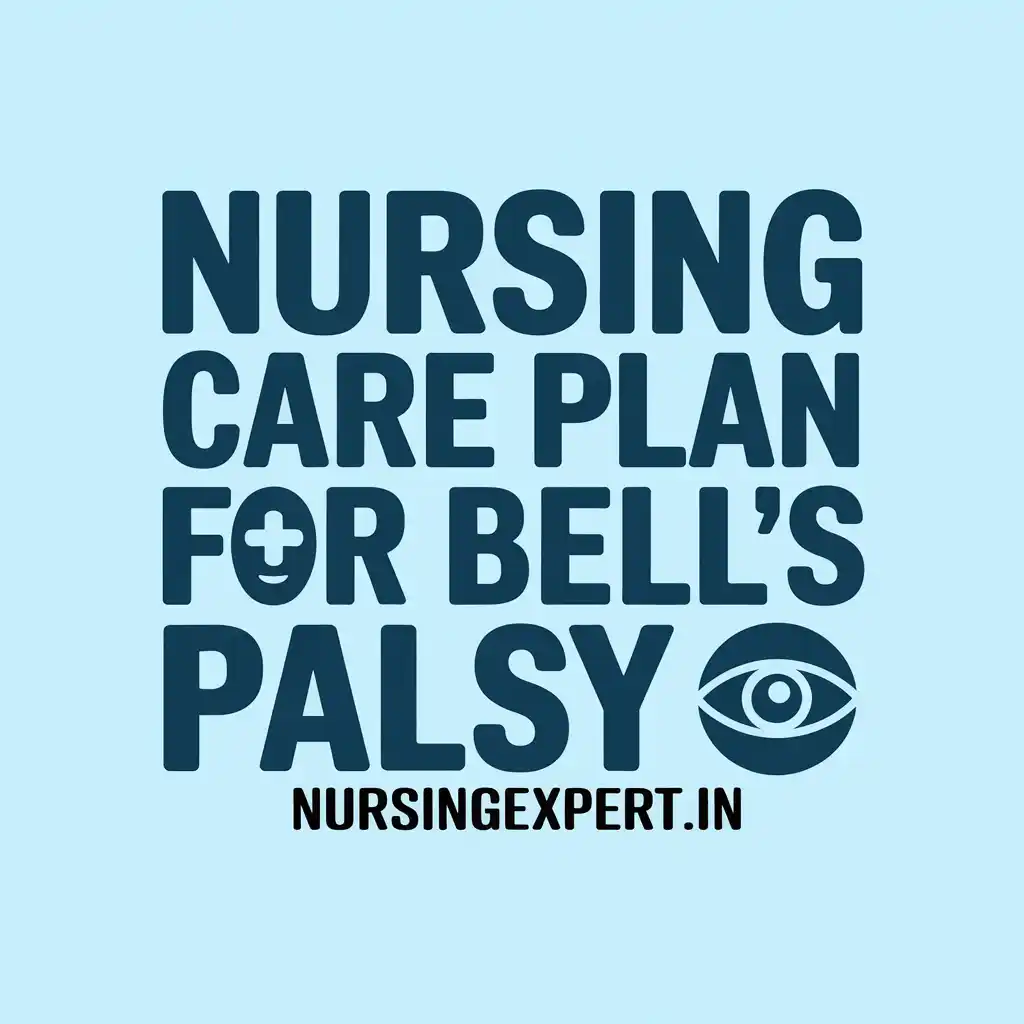This guide explains a complete Nursing Care Plan for Bell’s Palsy. Bell’s Palsy causes one side of the face to become weak or paralyzed due to a problem with the facial nerve. The plan helps nurses assess the patient, set goals, and choose interventions. A downloadable PDF is available for clinical use and exam preparation.
Thank you for reading this post, don't forget to subscribe!
1. Introduction
Bell’s Palsy causes sudden facial weakness. Nurses help patients manage symptoms, protect the eye, reduce pain, and learn self-care skills. This care plan guides nurses from the initial assessment to patient discharge.


2. Understanding Bell’s Palsy
Bell’s Palsy affects the facial nerve and leads to muscle weakness or paralysis on one side. Although the condition often improves on its own, early care can speed recovery and prevent complications.
3. Pathophysiology
Bell’s Palsy involves inflammation and swelling of the facial nerve. This swelling occurs inside a narrow bone canal. The compression of the nerve interrupts signals to facial muscles, causing weakness or paralysis.
- Inflammation: May result from viral infections.
- Nerve Compression: Swelling inside the facial canal disrupts signals.
- Muscle Weakness: Leads to drooping of the mouth and difficulty closing the eye.
4. Etiology and Risk Factors
The exact cause of Bell’s Palsy is not clear. However, several factors may increase the risk:
- Viral Infections: Reactivation of herpes simplex virus may trigger the condition.
- Inflammatory Conditions: Autoimmune responses may contribute.
- Diabetes: Vascular and nerve damage from diabetes can raise the risk.
- Pregnancy: Hormonal changes may increase susceptibility.
- Hypertension: High blood pressure can contribute to nerve compression.
5. Signs and Symptoms
Patients with Bell’s Palsy often show the following:
- Unilateral Facial Weakness: One side of the face shows weakness.
- Eye Closure Difficulty: The affected eye may not close completely, which can dry out the eye.
- Drooping of the Mouth: This affects speech and eating.
- Altered Taste: The taste sensation may change on the affected side.
- Increased Tearing or Dryness: Due to disrupted tear production.
6. Nursing Diagnoses
Nurses use the following common diagnoses when planning care:
- Impaired Facial Expression: The patient shows one-sided weakness.
- Risk for Injury: The inability to close the eye increases the chance of corneal damage.
- Acute Pain: The patient feels pain from nerve inflammation.
- Deficient Knowledge: The patient may not understand the condition or self-care strategies.
- Anxiety: The sudden change in appearance can increase worry.
7. Nursing Interventions
Nurses use several strategies to help manage Bell’s Palsy:
- Protect the Eye: Apply lubricating eye drops or ointment. Use an eye patch if needed.
- Manage Pain: Administer prescribed pain relievers and anti-inflammatory medications.
- Encourage Facial Exercises: Guide the patient in gentle exercises and massages to improve muscle function.
- Monitor Neurological Status: Regularly assess facial strength and eye condition.
- Educate on Medications: Explain the importance of following the medication schedule.
- Provide Emotional Support: Offer counseling and support to reduce anxiety.
- Ensure Safety: Teach safety measures to prevent falls and other injuries.
8. Nursing Management Strategies
The care plan follows a patient-centered approach:
- Comprehensive Assessment: Examine facial nerve function, pain levels, and eye condition on admission.
- Continuous Monitoring: Watch for changes in facial strength and eye protection.
- Early Intervention: Start protective and therapeutic measures as soon as symptoms appear.
- Patient Education: Explain the condition, treatments, and self-care practices.
- Regular Follow-Up: Schedule evaluations to track progress and update the care plan.
- Team Collaboration: Work with neurologists, ophthalmologists, physical therapists, and mental health professionals.
9. Patient and Family Education
Education is key for managing Bell’s Palsy:
- Explain the Condition: Describe the symptoms and expected recovery.
- Teach Eye Protection: Show how to use eye drops and ointments properly.
- Demonstrate Facial Exercises: Teach exercises to maintain muscle tone.
- Review Medication Use: Stress the importance of following prescribed treatments.
- Offer Emotional Support: Provide information about counseling and support groups.
- Promote Safety: Explain how to prevent accidents related to facial weakness.
10. Interdisciplinary Collaboration
A team approach improves care:
- Neurologists: Diagnose and monitor nerve function.
- Ophthalmologists: Ensure proper eye care to prevent injury.
- Physical Therapists: Create facial exercise programs.
- Mental Health Professionals: Help manage anxiety and emotional stress.
- Patient Educators: Reinforce self-care practices.
- Social Workers: Connect patients with community resources.
11. Sample Nursing Care Plan for Bell’s Palsy
| Assessment | Nursing Diagnosis | Goal/Expected Outcome | Intervention/Planning | Implementation | Rationale | Evaluation |
|---|---|---|---|---|---|---|
| Subjective: Patient reports sudden facial weakness and eye closure difficulty. Objective: One-sided facial drooping and mild pain are observed. | Impaired Facial Expression due to facial nerve dysfunction. | Short-Term: Partial improvement in facial movement within 24 hours. Long-Term: Improved facial symmetry through exercises. | Initiate facial muscle exercises; protect the eye with lubricants and a patch; monitor neurological changes. | Assist with daily exercises; apply eye drops and ointment as prescribed; document progress. | Early exercises and eye protection aid nerve recovery and prevent complications. | Patient shows gradual improvement and maintains eye protection. |
| Subjective: Patient feels anxious about appearance and disability. Objective: Patient shows signs of anxiety. | Anxiety due to altered appearance and fear of worsening disability. | Short-Term: Reduced anxiety within 24 hours. Long-Term: Use effective coping strategies and attend support sessions. | Provide emotional support; teach relaxation techniques; refer to counseling and support groups. | Offer individual counseling; encourage group participation; monitor anxiety levels. | Reducing anxiety improves well-being and adherence to care. | Patient reports less anxiety and shows improved coping. |
| Subjective: Patient is unsure about medication use and self-care. Objective: Patient asks questions and shows confusion. | Deficient Knowledge about Bell’s Palsy management. | Short-Term: Patient explains key self-care steps within 24 hours. Long-Term: Patient follows the care plan and shows improved self-management. | Develop a clear education plan covering medications, eye protection, and exercises; provide written and visual aids. | Conduct teaching sessions; distribute brochures; schedule follow-ups. | Education enhances self-care and treatment adherence. | Patient demonstrates better understanding and consistent self-care. |
12. Downloadable PDF Resource
You can download the complete nursing care plan for Bell’s Palsy. This PDF includes detailed steps, nursing diagnoses, interventions, and patient education strategies for effective management.
📥 Download Nursing Care Plan for Bell’s Palsy PDF
13. Frequently Asked Questions (FAQs)
What is Bell’s Palsy?
Bell’s Palsy is a condition that causes one side of the face to weaken or paralyze.
What are the common symptoms?
Symptoms include facial drooping, difficulty closing the eye, and changes in taste.
What is the primary goal of the care plan?
The plan aims to restore facial function, protect the eye, manage pain, and support the patient’s well-being.
Which interventions work best?
Facial exercises, eye protection, pain management, and patient education are key strategies.
How do nurses measure success?
Nurses look for improved facial movement, maintained eye protection, reduced pain, and positive feedback from the patient.
14. Conclusion
A structured nursing care plan for Bell’s Palsy helps manage both physical and emotional challenges. Nurses use assessments, targeted interventions, and education to support nerve recovery, protect the eye, and reduce anxiety. This guide is a valuable resource for clinical practice and exam review.
15. References and Sources
- Mayo Clinic. (2023). Bell’s Palsy: Symptoms and Treatment. Retrieved from Mayo Clinic
- MedlinePlus. (2023). Bell’s Palsy. Retrieved from MedlinePlus
- NANDA International. (2022). NANDA Nursing Diagnoses: Definitions and Classifications. Retrieved from NANDA International
- American Academy of Neurology. (2023). Bell’s Palsy Clinical Guidelines. Retrieved from AAN
- Centers for Disease Control and Prevention (CDC). (2023). Facial Paralysis: Overview and Prevention. Retrieved from CDC


